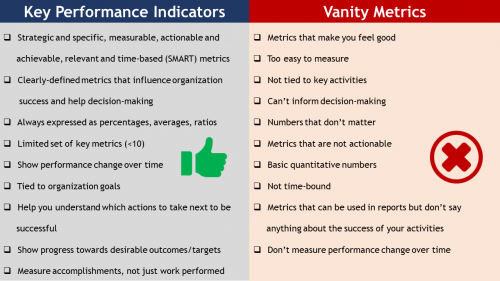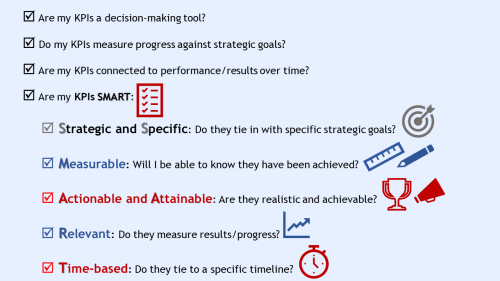
Meaningful KPIs in Four Easy Steps
December 18, 2018
Have you been tasked with developing Key Performance Indicators (KPIs) for your organization and don’t know where to begin? This quick primer can put you on the fast track!
We’ve all heard different variations of the phrase, “what gets measured gets done,” but how much of that is really true? What and how much of our activities do we need to measure to know whether or not we have achieved the desired results, and what changes to make moving forward?
Measuring and tracking key activities can incentivize employees to perform well and achieve success in specific areas. However, sometimes organizations can fall into the “metric trap” and drive for raw activity numbers rather than focusing on truly measuring key activities that influence their success. So how can we avoid inverse response behavior, where managers and employees end up focusing too much on numbers? Here are a few key questions you should ask before setting out on a performance measuring journey:
- What does success mean to my organization?
- What do I need to measure before starting to track performance?
- What are the right tools to use to measure meaningful results over time (quarter over quarter, or month over month)?
Metrics, measures, and KPIs are terms often used interchangeably. However, they cannot be more different. Not all metrics are KPIs, and not all measures are performance metrics. To further clarify the terms, think of measures as quantitative numbers, or the amount of something that is being measured. Metrics, on the other hand, are binary measures, derived from one or more measures. And finally, KPIs are key metrics that measure how an organization performs in the most critical areas by showing the progress or lack of it.
Word of caution: learn early on to differentiate between true performance metrics that measure your key activities and “vanity metrics.” Vanity metrics are just numbers that make you feel good. They are not actionable and don’t tell you anything of value about your organization’s success. You can use the chart below as a helpful tool to better understand the difference between true KPIs and “vanity metrics”.

Now that you’ve evaluated your organization’s unique needs, you are now ready to develop your KPIs to measure key activities for your organization. The KPIs should be tied to strategic goals and measure actual progress in key areas. Remember to always use metrics that help you evaluate your progress, rather than focusing on measures that tell you what you are doing at the present state.
Here are four easy steps to follow when you embark on your KPI journey:
STEP 1: Understand What Defines Your Success
Understand what is critical to your organization’s successful performance. Your performance indicators should be aligned with your strategic goals and objectives and enable performance measurement in those key areas.
Make sure you have a team in place to get input and buy-in from all levels of the organization.
STEP 2: Define your critical success areas/factors
Your critical success areas are high-level goals and key activities your organization should focus on to achieve optimal performance.
Focus on a small number of areas that are directly correlated to your strategic goals and objectives and have a direct impact on the organization’s efficiency and viability.
STEP 3: Gather All Your Measures and Select Key Metrics
Gather available measures/quantitative numbers for all key activities that can be quantified and used to measure your performance. This will help you identify your key metrics for each critical area.
Make sure your metrics measure efficiency, performance, progress, quality of your plans and processes against a baseline or a benchmark.
STEP 4: Define KPIs for Each Critical Success Area Based on Select Metrics
Choose relevant metrics and determine how you can use them to assess your performance. Effective KPIs are strategic metrics that quantify your critical success areas and measure your strategic performance. They tell you how successful your organization is in achieving its goals by measuring change that occurred from previous period, using specific targets, benchmarks against own performance, or comparable services or organizations. To know if your KPIs are the right metric for your organization, use the below checklist.
When you calculate your key performance indicators, make sure they are expressed as percentages, averages, or ratios.
Remember the rule of thumb: KPIs should be strategic, actionable, relevant, and in line with your strategy and goals.

Measuring success in state procurement has been among the top five NASPO Top Ten Priorities for State Procurement for four years in a row. This high ranking is not surprising given that procurement is a key strategic function for all government operations. Therefore, understanding what success means and using the right KPIs to track results in each state central procurement office around the country is critical.
Public procurement success can be defined by how transparent and efficient procurement processes are, how well the state central procurement office engages with internal and external stakeholders, including vendors and state agencies, and how much savings the central procurement office has achieved for the state. NASPO developed a set of critical success areas and effective performance metrics to aid state central procurement organizations in defining their own success metrics. If your procurement office is just now developing KPIs, reviewing the recommendations presented in NASPO’s Critical Success Areas and KPIs for State Procurement is a good place to start.
Best practice to achieve procurement success and get the most value out of your procurement activities includes having a comprehensive governance system in place from requisition to vendor payment, reliable eProcurement systems for tracking procurement activities, and skilled staff to interpret laws and analyze data.
In an effort to provide greater transparency, some states have implemented robust eProcurement and spend-analytics systems that allow for real-time and transparent reporting on procurement activities.
The KPIs developed by the Michigan Central Procurement Services Division to measure the success of the division’s operation have been recently recognized by NASPO, as a Bronze Winner of the association’s prestigious Cronin Award for Procurement Excellence and Innovation. The KPIs selected by Michigan had high visibility at all levels throughout the organization. Michigan’s internally-focused KPIs include critical areas such as customer satisfaction, hard savings, supplier performance and employee recognition. They are displayed on a large screen in the office, allowing employees and visitors alike to view a dashboard of the division’s daily performance. Visit NASPO’s Cronin Awards page to learn more about how Michigan implemented its KPI program.
Your KPIs can be as specific as applicable. The key is accountability, transparency, and measuring the right thing with the right tool/metric. In the end, they are all numbers. However, there is a big difference between numbers and numbers that matter. So, focus on the numbers that drive performance!
